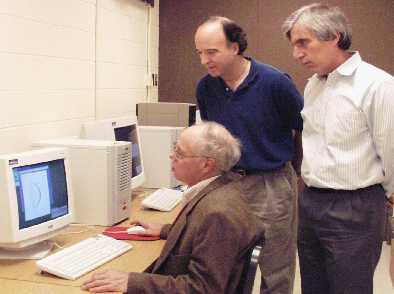LSC FACT SHEET
(November 2000)

1. Code Name: LSC (Lower hybrid Simulation Code)
2. Category: rf Modeling
3. Responsible Physicists: D.W. Ignat, D.C. McCune, S.C. Jardin, (left to right in photo) and E.J. Valeo (not pictured).
4. Others involved in code development: T.B. Terpstra, R. Kaita, S. Bernabei.
5. One line description: Lower Hybrid ray tracing for power deposition, Fokker Planck fits from Karney-Fisch to estimate the effect of the dc electric field (loop voltage) on rf driven current, optional heuristic diffusion of deposited power and current.
6. Computer systems which code runs on: Linux; PPPL Sun network; TRANSP machines; NERSC. Excepting graphics calls, the code is portable in that there are no library calls other than graphics.
7. Typical running time (if applicable): minutes if stand-alone; with a transport code it can be hours-to-days
8. Approximate number of code lines: 20K lines, *.F plus *.inc, including both graphics shells for SGlib and TV80-lib. With *.inc files expanded the code has many more lines.
9. Does this code read data files from another code? Yes, plasma equilibrium data from TSC and TRANSP.
10. Does this code produce data files that can be read by another code? If so, explain. Yes, plasma heating and current drive information by flux surface is written to files read by TSC and TRANSP.
11. 1-2 paragraph description of code: The Lower hybrid Simulation Code (LSC) is a computational model of lower hybrid current drive in the presence of an electric field. Details of geometry, plasma profiles and circuit equations are treated. Two-dimensional velocity space effects are approximated in a one-dimensional F-P treatment. The LSC was originally written to be a module for lower hybrid current drive called by the Tokamak Simulation Code (TSC) which is a numerical model of an axisymmetric tokamak plasma and the associated control systems. The TSC simulates the time evolution of a free boundary plasma by solving the MHD equations on a rectangular computational grid. The MHD equations are coupled to the external circuits (representing poloidal field coils) through the boundary conditions. The code includes provisions for modeling the control system, external heating, and fusion heating.
The LSC module can also be called by the TRANSP. TRANSP represents the plasma with an axisymmetric, fixed-boundary model and focuses on calculation of plasma transport to determine transport coefficients from data on power inputs and parameters reached.
12. Similar codes to this code, and distinguishing differences: Codes and modules due to P.T. Bonoli and co-workers are similar. Besides the original Bonoli code there are implementations in ACCOME and Baldur. The ACCOME is essentially static, but includes the Karney-Fisch estimate of the electric field effect. The Baldur treatment is dynamic, but does not include the Karney-Fisch calculation.
13. Journal References describing code (up to 3):
1. C. F. F. Karney and N. J. Fisch, Phys. Fluids, 180 (86).
2. D. W. Ignat, E. J. Valeo, and S. C. Jardin, "Dynamic Modeling of Lower Hybrid Current Drive," Nuclear Fusion , 837-852 (94).
3. D. W. Ignat, R. Kaita, S. C. Jardin, and M. Okabayashi, "Spreading of Lower Hybrid Wave-Driven Currents in PBX-M," Nuclear Fusion, 1733-1742 (96).
14. New code capabilities planned for next 1-2 years: Simplification of computational parameters, improved convergence for the standard input parameters, separation of graphics to post processing of numberical tables, support for post processing in SGLIB and GNUPLOT.
15. Code users: D. W. Ignat, S. C. Jardin, R. V. Budny, R. Kaita, and others
16. Present and recent applications of code: PBX-M; Tore Supra, TFTR-Extension, TPX
17. Status of code input/output documentation.
Check one:
( ) does not exist
( ) incomplete
(x) exists
See the:
LSC Manual (436 kB)
by D.W. Ignat et al and the
TSC Manual (640 kB)
by W. Daughton, S.C. Jardin, C. Kessel and N. Pomphrey.
The LSC Manual describes the version of November 2000 (and later) and will be not completely consistent with source code previous to mid-2000. The version of the TSC Manual is essentially unchanged since 1996 and may be out of date on some important details as of this posting. The TSC Manual was formatted into pdf January 2000 by D.W. Ignat using pdflatex and epstopdf with no intentional changes to the content.
18. Year Code was first used and present frequency of use: First used 1992, approximately. Used more or less continuously.
19. Estimate of Man-Years invested in developing code: 3, including understanding and repairing several subtle problems in the application to experiments, particularly PBX-M.
20. Categories of usage of Code (Check
all that apply):
(x) application code to do analysis and prediction of experiments
(x) numerical testbed of theoretical ideas
(x) physics module to be used in integrated modeling
(x) code for machine design
21. Language code is written in: Fortran 77, plus the do/enddo extension.
22. Results of inter-comparisons with other codes and results of validation against experiments. Many features of PBX-M are understood in terms of the computational results, such as location current as indicated by x-ray emission, and the changes in central q.